Matador Network's Blog, page 87
December 12, 2024
Tired of the Office Holiday Party? Try Japan’s ‘Forget-the-Year’ Party Instead.
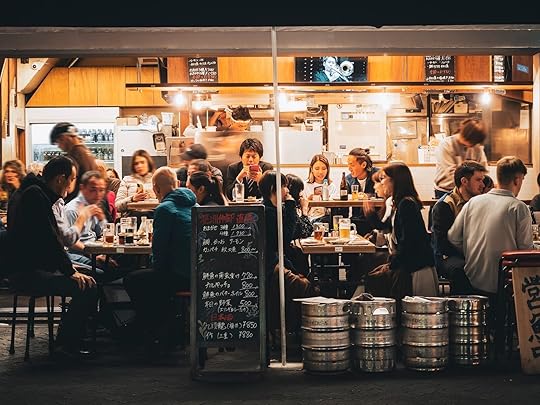
The end-of-year holiday party is a tradition in the United States. Calling it a beloved tradition would be a stretch — there’s a vast cultural catalog of TV shows, movies, books, and stories skewering the weird dynamics of a work holiday party. If you ask HR companies, there’s a strong chance you’ll hear something along the lines of holiday parties with free-flowing alcohol are a huge risk. Throw in the awkwardness of a party after companies have downsized ahead of the new year, and it would be hard to blame workers who suddenly can’t go because of a “surprise” last-minute obligation they can’t get out of.
End-of-year parties aren’t specific to the US, of course. And there’s an argument to be made that the theme in other cultures may (depending on your disposition and feelings about spending even more time with the people you work with) be more appealing. Take, for example, the Japanese tradition of bōnenkai.
Bōnenkai roughly translates to “forget the year party.” There are some similarities to holiday parties in the US — informal food, bottomless drinks, casual (perhaps too casual) conversations with work superiors, reluctance to attend by some. Attire differs, however, as workers typically wear the same thing they wear to the office, ties and all. The filter of Western religious holidays that often cover the parties in the US in some way big or small are absent. Bōnenkai also aren’t just limited to one company party, as various work departments and community groups will also hold the events in smaller groups.
The biggest difference is that bōnenkai don’t shy away from the beverages, particularly beer and sake. In fact, with “forgetting” being a major component, the drinks often take a central place.
“The first character is bo, to forget,” Kisa, who works with Sapporo, said during a demonstration bōnenkai done over video call with members of the Sapporo teams in Japan and California. “You have such a great time that you forget all the troubles of the year and look forward to the new year. Today, you see a lot of drinking on the street and letting of all the things people experienced at the end of the year.”

For the year of the snake in 2025, Sapporo tapped tattoo artist Tokyo Hiro for the design. The open- and closed-mouth snakes symbolize the year ending and the beginning of another, and peonies represent good luck. Photo: Sapporo
These large company parties are typically held in izakaya, which are casual Japanese bars that also serve snacks like skewered meat and fried bites. Someone high up in the company gives an opening speech with drink in hand. The year past is discussed before a raised glass and kanpai (cheers). Only then can the eating and drinking commence — and lots of it. Japanese tradition holds that empty glasses should be filled by others (particularly by those lower down the totem pole and always poured with two hands, called oshaku), so empty glasses are a bit of a rarity.
There’s some time to fill up and get a buzz before the entertainment: karaoke is popular, as are little staged shows that poke fun at a cultural moment from the past year. More drinks and food follow. It all ends with sanbon-jime — a rhythmic clap done in unison and led by someone higher up (Hiro Kitaoka, chairman of the Sapporo-owned Stone Brewing led ours on the video bōnenkai): three successive claps and then one closing clap, repeated for a total of three times. One last hurrah and the bōnenkai is done (except for those who want to continue the drinking at the nijikai, or after party).
It all sounds like a modern occasion, but bōnenkai has a centuries-old history. The precursor in the 15th century were nōkai (“great achievement gathering”). They transitioned to bōnenkai in the 18th century. By the Meiji period in the late 1800s, the tradition was solidified across classes.
Coincidentally, this was also about the same time that Japan’s oldest brewery was founded. Seibei Nakagawa illegally left his home country and fell in love with beer in Europe, learning the trade in Germany and becoming a certified brewmaster. When Japan’s isolationist laws ended and the country’s leaders wanted an internationally-minded brewery, Nakagawa came back and founded Sapporo in 1876. Beer may not have been the widespread drink of choice in those early bōnenkai years, but it surely is the most reached for beverage now. Japan is the 10th most beer-consuming country in the world.
Big or small, bōnenkai is a loose and free flowing end-of-year party for those tired of the well-worn US holiday party. Sometimes we can all use a little forgetting to get refreshed and ready for what’s to come in the year ahead. 
December 11, 2024
Surrey’s Cottage Core Airbnbs Help You Live Out ‘The Holiday’ IRL

If you’re dreaming of a cozy little cottage down a narrow tree-draped lane in England, perhaps called Honeysuckle Cottage or something of that ilk, you’ve likely re-watched The Holiday recently. If so, and you are feeling inspired to plan a rural trip to the UK, Surrey, England, where the film was shot, is a perfect place to start. I say this because it’s under a two-hour drive from London. People commute on trains from this region into the city on a daily basis. It’s that well-connected. So, this region is a superb base if you fancy teaming up a city jaunt to the capital with a few days in the English countryside. Aside from a drunken Jude Law stumbling into your cottage — trust me, that will never happen — rural life here in the UK is pretty similar to how it’s portrayed in the movies. The views are breathtaking, the community spirit is warming, the kettle is always on, pubs have fireplaces, and many of us live in dreamy cottages with low beamed ceilings, kitchen stoves, and no neighbors. If that sounds like heaven to you, check out these Airbnbs in Surrey. Unless you can pack like Diaz and hot tail it across the pond, it might be too late for an adventure this Christmas, but these storybook rentals deserve to be bookmarked.
We hope you love the Surrey, England Airbnb rentals we recommend! Just so you know, Matador may collect a small commission from the links on this page if you decide to book a stay. Listed prices are accurate as of the time of publication.
Country home with amazing views in the heart of Surrey Downs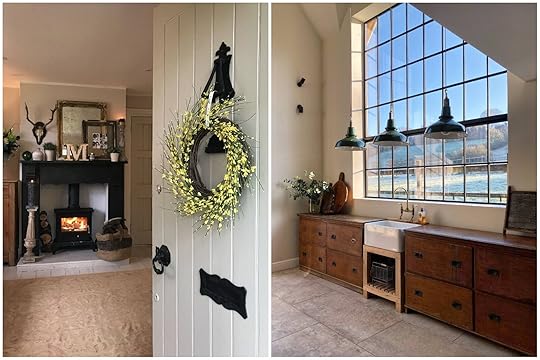 Photo: Airbnb
Photo: Airbnb Photo: Airbnb
Photo: Airbnb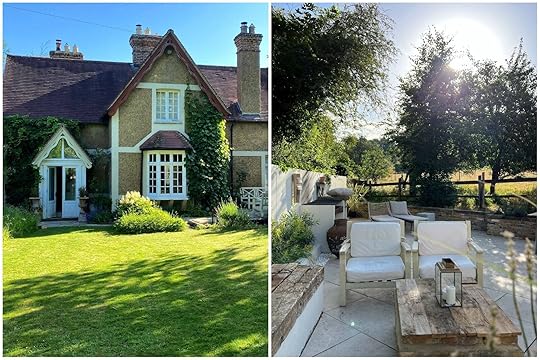 Photo: AirbnbSee more photos
Photo: AirbnbSee more photosThis beautiful, family-friendly country cottage is in Chipstead, in the heart of Surrey Downs. With a quick look (ok, I went down a rabbit hole) at houses for sale in the area, you’d need lottery money to live here. The area is picture-perfect, surrounded by rolling hills, woodland, nature reserves, and lovely local pubs with names like Ramblers Rest. This is an excellent find if you’re traveling with family and friends. It sleeps up to six and is set on half an acre of gardens. It has a Mediterranean-style outdoor area with a built-in BBQ and a bright and spacious farmhouse kitchen with countryside views. There are three double bedrooms, a comfortable lounge for afternoon tea, a playroom for kids, and a study.
Six guests, three bedroom
Price: $575 per night
 Photo: Airbnb
Photo: Airbnb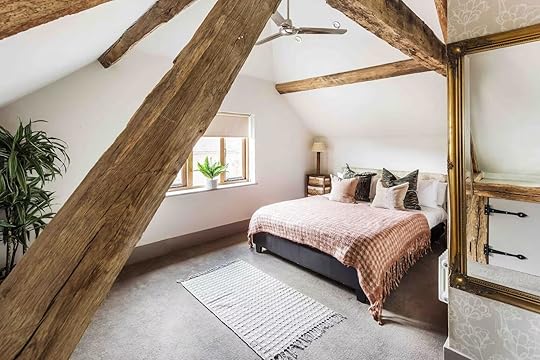 Photo: Airbnb
Photo: Airbnb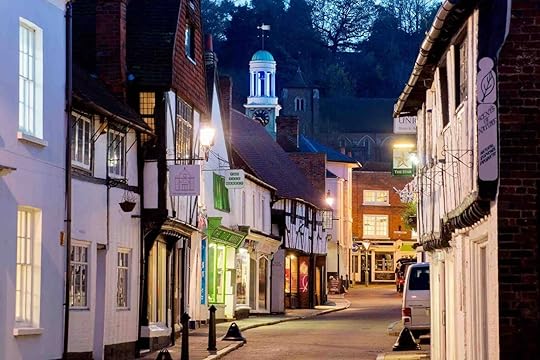 Photo: AirbnbSee more photos
Photo: AirbnbSee more photosYou might have to rush to beat me to booking this barn in Witley. Witley is around an hour from London, making it another place in the South that’s quite exclusive because people can commute into the city and be on a capital-level salary but, at the end of the day, retreat to the countryside. The village is small. It has a post office and shop (where you’ll likely get the local gossip) and a few pubs and restaurants. If you love the outdoors, you won’t need organized sports here. You can simply walk out the front door and hike, cycle, or horse ride into the surrounding hills. The barn’s host, Kate (no, I’m not joking here), has rave reviews from past guests, making this rental extremely popular, so booking in advance is recommended. It sleeps four guests in king-sized bedrooms and there’s secure gated parking.
Four guests, two bedroom
Price: $245 per night
 Photo: Airbnb
Photo: Airbnb Photo: Airbnb
Photo: Airbnb Photo: AirbnbSee more photos
Photo: AirbnbSee more photosIf you’re a solo traveler wanting an escape, this is the one for you. Again, we can’t promise a visit from Jude Law, but you might fall in love with this one-bedroom studio instead. It’s one of Airbnbs top five percent listings. It’s five minutes from the pretty town of Windsor and has direct views of Windsor Great Park and the castle — the oldest occupied castle in the world, home to 39 monarchs over 900-year history. The studio sits on a private estate once owned by King Henry VIII and is surrounded by trees and woodland wildlife. It’s the perfect rental if you want the tranquility of the countryside and the hustle and bustle of a market town. Keep in mind, however, that come summer, Windsor is incredibly busy with both UK and international visitors, so you’ll need to make reservations for dinner, etc, in advance.
Three guests, one bedroom
Price: $258 per night
 Photo: Airbnb
Photo: Airbnb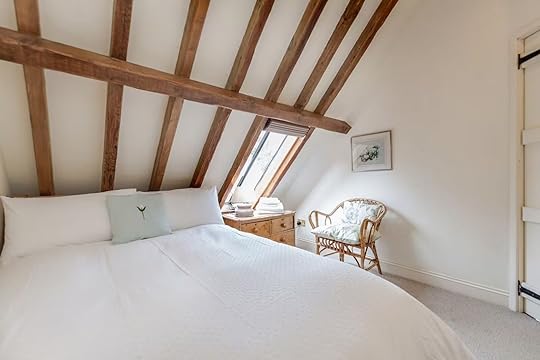 Photo: Airbnb
Photo: Airbnb Photo: AirbnbSee more photos
Photo: AirbnbSee more photosThis is another great find for groups and families who want an English countryside escape where the only nearby traffic is horse riders and walkers. Here, you’ll be surrounded by beautiful meadows, woodlands, and wildlife, and you can stroll into the ancient village of Dorking to browse antique shops, get some produce at the farmers market, and have a pint in the pub. This stylish barn conversion set on a 15th-century farm. It ticks all the boxes: wood-burning stove, farmhouse kitchen, and beamed ceilings. If you need more space, there’s a stable cottage available to rent that sleeps four and a hayloft that sleeps an extra two guests.
Six guests, three bedroom
Price: $319 per night
 Photo: Airbnb
Photo: Airbnb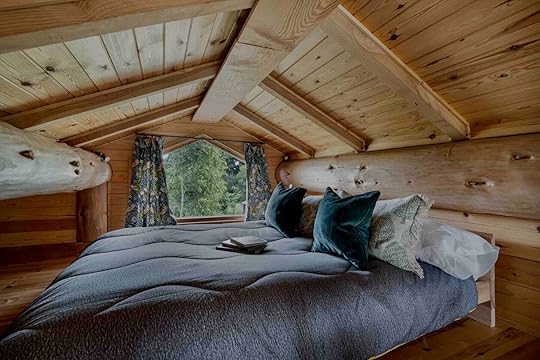 Photo: Airbnb
Photo: Airbnb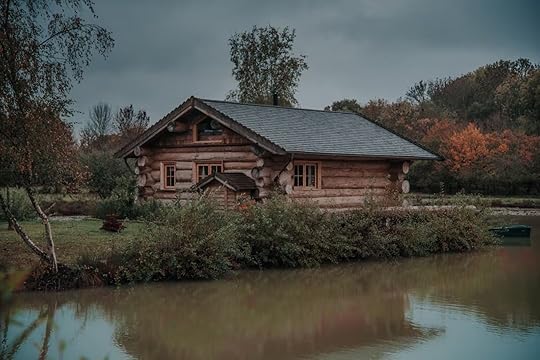 Photo: AirbnbSee more photos
Photo: AirbnbSee more photosIf you really need to get away from it all, check out this luxury log cabin. It’s set in the middle of a private five-acre island near Newdigate. Still, you’ll be able to drive to a well-stocked village and farm shop to stock up on wine in five or so minutes and there’s a decent pub nearby too. This is another top percent listing on Airbnb, awarded for exceptional guest reviews. You’ll have private access to the lake. If you’re there during summer you can fish, swim, or paddle board. In winter, you can snuggle down by the fire, drink all your wine, read, and check-out for a few days. Sounds like heaven to me. 
Four guests, two bedroom
Price: $319 per night
Surrey’s Cottage Core Airbnbs Help You Live Out The Holiday IRL

If you’re dreaming of a cozy little cottage down a narrow tree-draped lane in England, perhaps called Honeysuckle Cottage or something of that ilk, you’ve likely re-watched The Holiday recently. If so, and you are feeling inspired to plan a rural trip to the UK, Surrey, England, where the film was shot, is a perfect place to start. I say this because it’s under a two-hour drive from London. People commute on trains from this region into the city on a daily basis. It’s that well-connected. So, this region is a superb base if you fancy teaming up a city jaunt to the capital with a few days in the English countryside. Aside from a drunken Jude Law stumbling into your cottage — trust me, that will never happen — rural life here in the UK is pretty similar to how it’s portrayed in the movies. The views are breathtaking, the community spirit is warming, the kettle is always on, pubs have fireplaces, and many of us live in dreamy cottages with low beamed ceilings, kitchen stoves, and no neighbors. If that sounds like heaven to you, check out these Airbnbs in Surrey. Unless you can pack like Diaz and hot tail it across the pond, it might be too late for an adventure this Christmas, but these storybook rentals deserve to be bookmarked.
We hope you love the Surrey, England Airbnb rentals we recommend! Just so you know, Matador may collect a small commission from the links on this page if you decide to book a stay. Listed prices are accurate as of the time of publication.
Country home with amazing views in the heart of Surrey Downs Photo: Airbnb
Photo: Airbnb Photo: Airbnb
Photo: Airbnb Photo: AirbnbSee more photos
Photo: AirbnbSee more photosThis beautiful, family-friendly country cottage is in Chipstead, in the heart of Surrey Downs. With a quick look (ok, I went down a rabbit hole) at houses for sale in the area, you’d need lottery money to live here. The area is picture-perfect, surrounded by rolling hills, woodland, nature reserves, and lovely local pubs with names like Ramblers Rest. This is an excellent find if you’re traveling with family and friends. It sleeps up to six and is set on half an acre of gardens. It has a Mediterranean-style outdoor area with a built-in BBQ and a bright and spacious farmhouse kitchen with countryside views. There are three double bedrooms, a comfortable lounge for afternoon tea, a playroom for kids, and a study.
Six guests, three bedroom
Price: $575 per night
 Photo: Airbnb
Photo: Airbnb Photo: Airbnb
Photo: Airbnb Photo: AirbnbSee more photos
Photo: AirbnbSee more photosYou might have to rush to beat me to booking this barn in Witley. Witley is around an hour from London, making it another place in the South that’s quite exclusive because people can commute into the city and be on a capital-level salary but, at the end of the day, retreat to the countryside. The village is small. It has a post office and shop (where you’ll likely get the local gossip) and a few pubs and restaurants. If you love the outdoors, you won’t need organized sports here. You can simply walk out the front door and hike, cycle, or horse ride into the surrounding hills. The barn’s host, Kate (no, I’m not joking here), has rave reviews from past guests, making this rental extremely popular, so booking in advance is recommended. It sleeps four guests in king-sized bedrooms and there’s secure gated parking.
Four guests, two bedroom
Price: $245 per night
 Photo: Airbnb
Photo: Airbnb Photo: Airbnb
Photo: Airbnb Photo: AirbnbSee more photos
Photo: AirbnbSee more photosIf you’re a solo traveler wanting an escape, this is the one for you. Again, we can’t promise a visit from Jude Law, but you might fall in love with this one-bedroom studio instead. It’s one of Airbnbs top five percent listings. It’s five minutes from the pretty town of Windsor and has direct views of Windsor Great Park and the castle — the oldest occupied castle in the world, home to 39 monarchs over 900-year history. The studio sits on a private estate once owned by King Henry VIII and is surrounded by trees and woodland wildlife. It’s the perfect rental if you want the tranquility of the countryside and the hustle and bustle of a market town. Keep in mind, however, that come summer, Windsor is incredibly busy with both UK and international visitors, so you’ll need to make reservations for dinner, etc, in advance.
Three guests, one bedroom
Price: $258 per night
 Photo: Airbnb
Photo: Airbnb Photo: Airbnb
Photo: Airbnb Photo: AirbnbSee more photos
Photo: AirbnbSee more photosThis is another great find for groups and families who want an English countryside escape where the only nearby traffic is horse riders and walkers. Here, you’ll be surrounded by beautiful meadows, woodlands, and wildlife, and you can stroll into the ancient village of Dorking to browse antique shops, get some produce at the farmers market, and have a pint in the pub. This stylish barn conversion set on a 15th-century farm. It ticks all the boxes: wood-burning stove, farmhouse kitchen, and beamed ceilings. If you need more space, there’s a stable cottage available to rent that sleeps four and a hayloft that sleeps an extra two guests.
Six guests, three bedroom
Price: $319 per night
 Photo: Airbnb
Photo: Airbnb Photo: Airbnb
Photo: Airbnb Photo: AirbnbSee more photos
Photo: AirbnbSee more photosIf you really need to get away from it all, check out this luxury log cabin. It’s set in the middle of a private five-acre island near Newdigate. Still, you’ll be able to drive to a well-stocked village and farm shop to stock up on wine in five or so minutes and there’s a decent pub nearby too. This is another top percent listing on Airbnb, awarded for exceptional guest reviews. You’ll have private access to the lake. If you’re there during summer you can fish, swim, or paddle board. In winter, you can snuggle down by the fire, drink all your wine, read, and check-out for a few days. Sounds like heaven to me. 
Four guests, two bedroom
Price: $319 per night
Live Like a Modern Professional Cowboy at This All-Inclusive Montana Ranch Resort
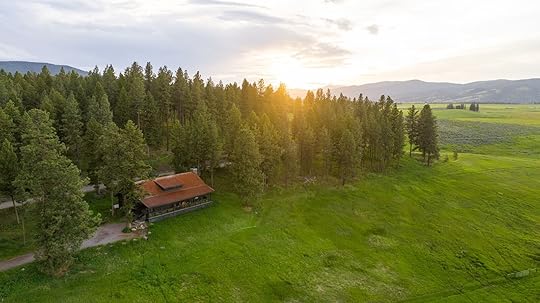
For Paws Up Montana imagery, see these images https://app.air.inc/a/b9UsoUWnM
As you’re pulling into The Resort at Paws Up Montana, it doesn’t feel like visiting any other regular hotel or resort property — it feels like you’re returning home to your family’s cozy Western ranch home. Paws Up Montana is a family-owned property surrounded by open blue skies and grassy pastures, plopped in the middle of a wide open space in Greenough, Montana, 35 miles northeast of Missoula. While this sprawling western Montana property is technically still a working cattle ranch, it’s also a place open for audaciously spirited visitors to stay, create unforgettable memories, and live out fantastical wild west cowboy dreams. The rustic yet elevated and sophisticated ambiance balances adventures with elegance and is an outdoor lovers’ dream come true, any time of year. On a recent visit, I learned why.
What to expect during a stay at The Resort at Paws Up Montana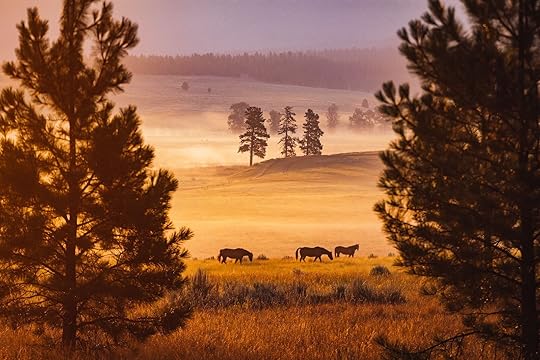
Photo courtesy Paws Up Montana
There are a plethora of active adventures available to enjoy at Paws Up Montana, ranging from the 100 miles of hiking trails nearby to mountain biking trails, equestrian experiences, and more. One of the most standout details of planning a visit to Paws Up is that it’s one of the only all-inclusive resort properties in the U.S., and the only one that combines such sophisticated resort amenities with dude ranch vibes. Plus, it’s even dog-friendly (my pup was greatly spoiled with the open space and comfortable dog beds during our visit).
Every stay begins and ends with complimentary round-trip airport transportation from Missoula Montana Airport for those who fly in — and guests don’t have to worry about how they’ll get around while they’re on-site, because a booking also includes access to a personal Lexus NX for on-property transportation (for luxury home guests) and on-demand shuttle services (for camp guests).
All daily meals (breakfast, lunch, and dinner), nonalcoholic beverages, and a selection of wine, beer, and select cocktails are included (and those who want a “premium” spirit in their cocktail just need to pay a bit more for the individual selection — but otherwise, standard liquors are covered).
Guests also have access to non-guided on-site activities like hiking, but it’s important to note that just as most other “all-inclusive” properties, the spa treatments and bookable adventure activities (like archery, or an ATV tour) are not part of the “inclusive” package. However, perhaps one of the most notable (and one of my favorite) elements of the “inclusive” model is that tips are included, so you’ll never have to worry about signing a check after dinner or doing the math on how much to leave your server or activity guide.
I spent three nights on-site with my dog and my husband in late October, and it felt like we were the only people on the 37,000 property — as if we had the whole place to ourselves.
I can only speak to what the resort feels like during autumn, outside of the official summer or winter season, when the activities change, and the “glamping” tents had been shuttered for the season. But in the high season, this resort boasts accommodations for up to 275 guests across 28 luxury homes and 36 glamping tents (with seasonal availability). And it’s not your standard “resort” layout.
Accommodations at The Resort at Paws Up Montana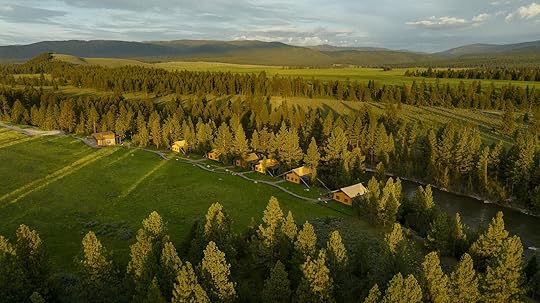
The Meadow Homes. Photo courtesy Paws Up Montana
While driving to the guest welcoming/reception area of The Village after pulling off a vast stretch of rolling hilled highway leading up to the property (blink, and you’ll miss it), you’ll likely spy a glimpse of wildlife lazily grazing on the pasture. The 300-head herd of resident elk, some of the hundred Black Angus cows, and the savvy deer who have figured out they’re safe from the local hunters’ range while on Paws Up land roam free.
I checked in and headed to my cozy single-story Meadow Home, which can be an ideal setup for couples, families, and friends who want to spend time together — but also seek their own space. My cabin had 1,100 square feet of space with two bedrooms and two bathrooms, as well as a full living room and a sizable deck with a hot tub. I can’t speak to how the glamping tents are decorated — but our Meadow Home felt like it was set in a classic sort of Western-chic flair and furnished with upscale design touches, like leather couches and timber and iron headboards.
One of my favorite elements of design in my Meadow Home was the comfortable, large bathroom, which featured the much-appreciated luxury of a heated granite-tile floor. It honestly hurts to go back to non-heated floors once you’ve experienced this special flavor of opulence.
The Meadow Homes also feature a large kitchen with a full-sized refrigerator, microwave and dishwasher — as well as a dining room table and chair set to gather around for games and meals.
In the cozy living room, there’s a big flat-screen TV with satellite programming and access to subscription services for shows and movies (I caught up on a fair amount of my Netflix binge-watching while relaxing each night).
The outdoor hot tubs are another incredible detail when spending time in one of the luxury home accommodations. Even though it dropped down into the 30s after dark, I was cozied up in the hot tub, stargazing every single night.
Dining at The Resort at Paws Up Montana
Photo courtesy Paws Up Montana
The seasonal, outdoors-focused dining outlets were closed for the winter while I was visiting (this includes outposts like Shed and Chuck Wagon — which I’ve heard are great), which left the remaining “year-round” outlets at the “Cook Shack” area, which is centrally located near the entrance to Paws Up and the village. This spot is known as the resort’s “culinary headquarters” and is where the two year-round restaurants and full-service bar are situated.
Dine at Pomp if you’re seeking something sophisticated. This is the upscale gourmet restaurant, which serves “continental cuisine with a Western flair” using local ingredients (which means the menu is constantly changing with each season — and I appreciated that this team is very attuned to your individual dietary needs).
We had to make a reservation to eat here, but they knew my allergies upfront, which was helpful. I was told the team seemingly builds the nightly three-course menu with various options folks can choose from depending on their taste — including a vegetarian option, one kind of red meat dish, and one kind of light meat dish like chicken or fish.
Next door at Trough, it’s a more casual mood for dining, with menus offering hearty options for breakfast, lunch, and dinner. Finally, Tank features a selection of the “finest drink selections in the West” in a casual environment with a spirited atmosphere, including flat-screen TVs for watching sports (but you honestly might be too distracted by the awe-inspiring views of the rolling hills and wildlife outside).
And there’s, of course, in-room dining service — which means if you’re as wiped out as I was the day we arrived (after a lengthy drive up from Colorado since my dog is too big to fly) I was able to eat in the comfort of my own cabin in pajamas.
The IRD menu featured many of the same menu items served at the restaurants. There’s also a special delivery option for those staying in the luxury home accommodations who crave a simple and comforting pizza pie — the Grizzly Gourmet Pizza Delivery. Because sometimes, even when you’re out in the Montana wilderness, you just need a pizza (their menu also offers salads, sides, and desserts).
Spa at The Resort at Paws Up Montana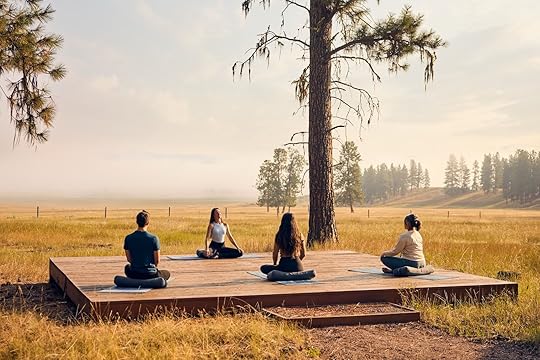
Photo courtesy Paws Up Montana
Again, I was staying on-site in the fall when the property’s full-fledged outdoor “Spa Town” had already been taken down — but from what I could see, the Spa Town setup at Paws Up Montana looks like a gorgeous setup. There’s a lineup of relaxing canvas tents (which have full baths and heated massage tables) connected by a dreamy wooden boardwalk nestled into a hill on the property overlooking the plains. The idea of spending time in Spa town is for you to feel “lost in the woods” with a state of total immersion into nature while you’re enjoying your treatment.
For fitness fanatics who need more than a trail ride or a hike outdoors, the indoor 24/7 gym space is sizable and clean, featuring elliptical machines, free weights, medicine balls, stationary bikes, and treadmills.
Activities and on-site entertainment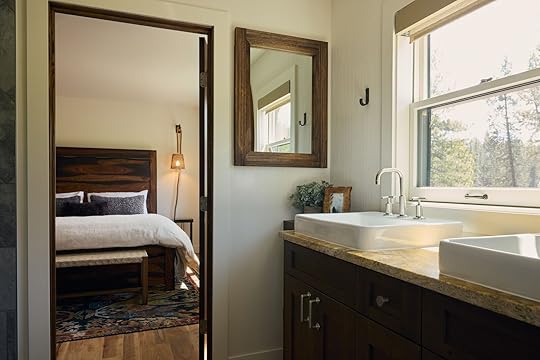
Interior of a Meadow Home. Photo courtesy Paws Up Montana
No matter how many days you’re planning to visit Paws Up, you’ll never run out of things to do. This property has its own 37,000 acres of space, including the aforementioned 100-plus miles of trails, and it’s close to the 1.5-million-acre Bob Marshall Wilderness, which means seemingly endless opportunities for outdoor escapades.
I was lucky enough to try a few different activities during my visit. On a private hike, my local guide was incredibly well-versed in the flora found across our pathway. She’d point out various plants and tell me what they were (or still are) used for in natural healing practices. It was fascinating to learn about how when we’re outdoors, we’re surrounded by natural medicines and sustenance — if we know where to look for it.
After the hike, the guide led a sound bath experience for me, which took place in the ethereal-feeling glass house at Spa Town, bathed in sunlight and with an inspiring view of the rolling plains.
In an archery session, I was pleasantly surprised by how interactive our guide was in helping me live out my fantasy of shooting arrows like Katniss Everdeen (albeit with far worse accuracy and endurance). Archery participants are taken into a special area of the woods on the property near the Meadow Homes, onto a course with ten different archery stations outfitted with foam animals (the bear and jackalope were my favorite targets) set in the woods. There are even two elevated platforms to simulate a tree stand.
On a guided ATV tour, we sped around the property, seeing various sights and learning about the gripping history of the land on which Paws Up Montana lives (its stories date back hundreds of years).
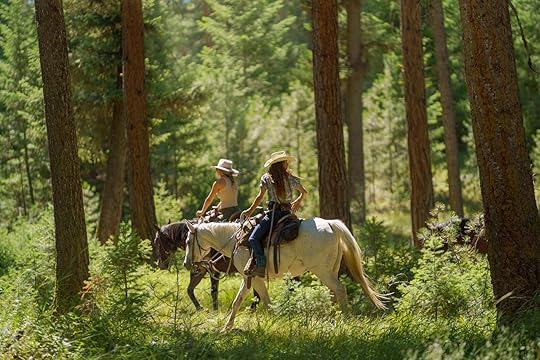
Photo courtesy Paws Up Montana
But perhaps the most unique experience I had while visiting Paws Up was participating in a real-life “Cattle Drive.” I was admittedly nervous about this activity while preparing to participate, looking back. I’d seen cattle drives before, and it looked like the cowboys and cowgirls had such a strong presence and skill while herding these independent animals with their horses.
In reality, there was nothing to be nervous about — but as someone who has only ridden on a few horses, I didn’t know what to expect and didn’t have much confidence in my personal “herding” abilities. When we arrived at the Saddle Club facility (which actually hosts a ton of activities for those interested in this special brand of “horseplay,”) we were matched with our own horses by one of the guides based on our personalities and equestrian experience.
We saddled up and spent about 45 minutes taking the reins (pun intended), learning the ropes, and bonding with our horses while figuring out how to work with them. I no longer felt intimidated by the time we set off for the action. I still couldn’t believe I was actively participating in an essential activity on this working ranch.
We rode out to the field, where dozens of 800-pound Corriente cows were grazing. We used the techniques we had been taught on how to herd the cattle in a certain direction, and it turned out to be much more straightforward than I’d expected. The cattle drive became a sort of spiritual experience. There was mutual respect between the horses and the cattle, a powerful symbiotic relationship where the horses used their unspoken (but palpable) influence and presence to get the enormous cows to meander all together in a specific direction.
We rode our animals around the cows in certain formations, catching stragglers and nipping the ones who tried to defy the horse’s power. We led them in a direction toward a specific Paws Up pasture where they’d stay for the night.
When we finished the herding, we turned and guided our horses back toward the Saddle Club. It was golden hour, and the rays of sun filtering through the dust in the air from our horses’ rhythmic clomping hooves were shining down on the Montana countryside as if we were all starting in a dreamy movie instead of real life.
We were by then an accomplished team of wranglers. One guest asked (and it didn’t sound like he was completely joking) if Paws Up was hiring — because he’d love to join them on a regular basis. They actually said, “yes.”
The Cattle Drive was an incredibly unique activity offered at Paws Up — and I feel like it could serve as both an educational and personally transformative experience for anyone who’s willing to respectfully give it a try.
Come for the seclusion, freedom, and open space — come back for the community atmosphere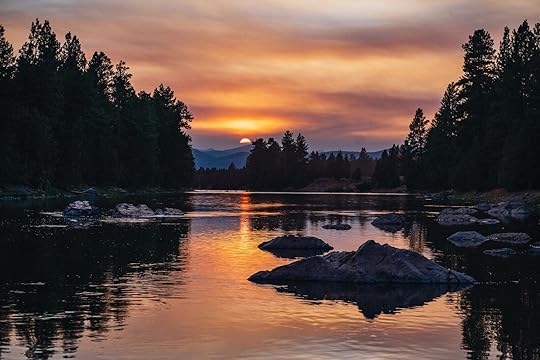
Photo courtesy Paws Up Montana
Everyone who works at Paws Up is warm, welcoming, and passionate about the property, and you can feel it while you’re visiting. The food is tasty, the drinks are expertly curated, and the activities are potentially life-changing (especially if you do end up quitting your job and joining their team as a wrangler). The accommodations are an adventure — but the folks who make the experience feel worthwhile are the reason so many guests return year after year to make Paws Up Montana their regular vacation spot to spend time with family and friends. 
Miami Is a Rum Lover’s Paradise. This Rum Bar Crawl Features Some of the Best Cocktails in Vice City.

Being just a stone’s throw away from Caribbean islands, Miami is naturally a prime destination for fans of rum. Rum — distilled from sugar cane or molasses that is the key ingredient to Tortuga cakes and classic tropical cocktails like the piña colada — needs no introduction. Yet the spirit gets special attention in Vice City, and both rum lovers and those who haven’t quite found how they like their rum served will find new favorites.
On a Miami rum tour with the team from Diplomático, I embarked on a bar crawl to several local hot spots to explore some of the most iconic rum drinks served around the city. You’re sure to find something you enjoy here, from strong to fruity to easy drinking.
The Social ClubView this post on InstagramA post shared by The Social Club (@socialclubsobe)
I started at The Social Club in the Kimpton Surfcomber Hotel, an Art Deco staple of Miami Beach. As strange as it sounds, many (if not most) local haunts in Miami tend to be hotel bars. Why? Hotels know how to take care of customers, and the bars tend to be the chicest and swankiest in town (especially compared to your typical dive bar with questionable hygiene that you age out of after college).
Nestled between the busy tourist strip of Collins Avenue and the beach, The Social Club is a great spot to land after a sunset stroll on the boardwalk. If the smell of food behind you makes your stomach growl, take a seat where the venue also serves dinner. Main plates like the snapper, salmon, or steak start at $40, but listen, that’s what you have to pay in Miami Beach to get away from noisy tourists. A classic rum cocktail will quickly make you forget about sticker shock.

Photo: Keven Gungor
What to try: A daiquiri with the perfect balance between silky rum and sour lime juice. For a daiquiri you know you’ll enjoy, request Planas, Diplomático’s only clear rum that is charcoal-filtered and has the ideal consistency and flavor for the perfect classic daiquiri.
The Social Club: 1717 Collins Ave, Miami Beach, FL 33139
Miami Sound BarView this post on InstagramA post shared by Miami Sound Bar (@miasoundbar)
Next, I strolled into a mixology class at the clandestine Miami Sound Bar downtown. It’s easy to miss without the address on hand — from the outside, it is hard to tell what this place is all about and it looks more like a sushi joint for secret business meetings than a retro record bar.
While the bartender was teaching us about ratios of liquor to juices and syrups, my eyes wandered to the vinyls behind her. The bar itself even has a built-in turn table, so that you can sip while both listening and watching a master at work. What I love about bars like this is forced intimacy: there’s no dance floor, or an awkward distance from one corner to the other. It’s a corridor-shaped lounge where you’re either seated at the bar or on the couch a few feet away. There’s no frou frou along with the great cocktails — you’re either here to listen to great vintage records, or to chat with the person next to you (or both).
What to try: A 1989 Sunset — made with a base of Diplomático Mantuano along with rose water, orange blossom water, club soda, and, the kicker, date syrup to create a refreshing blended cocktail.
Miami Sound Bar: 123 SE 2nd Ave, Miami, FL 33131
dōmaView this post on InstagramA post shared by dōma restaurant (@domamiami)
While dōma is the only spot on this list that isn’t technically a bar, it’s worth a mention for a few reasons. Though there is a bar right at the entrance, it’s not a proper visit to Miami without a courtyard seating (especially mid-winter). This particular courtyard captures Miami perfectly. dōma is in Wynwood, a once-grungey neighborhood that has been become a Miami hotspot as gargantuan warehouses turned into nightlife venues and barren, industrial walls transformed into modern murals. Today, Wynwood is one of the Miami tourist spots that’s actually worth seeing. But when you find yourself in a courtyard like dōma’s, with lush greenery enveloping its corners, suddenly you remember you’re in a tropical climate despite the urban, concrete backdrop outside of this enclave.
dōma serves Italian dishes, with pasta plates starting at about $35 and meat and fish entrées at about $45. Yes, Italian food is paired best with wine, but I was surprised to find my favorite rum cocktail on this tour was served in this restaurant.

Photo: Keven Gungor
What to try: The Mr. Juancho, which is made with Diplomático’s Reserve Exclusiva, lime juice, mint syrup, and prosecco. Bringing all of these ingredients together in one beverage, and the way those flavors blended together, made this my favorite rum drink of the trip. The effervescence of prosecco and the cooling effect of mint both bring a refreshing blast, while the lime juice adds just enough acidity to appreciate the bold rum.
dōma: 35 NE 26th St, Miami, FL 33137
Cafe La TrovaView this post on InstagramA post shared by Café La Trova (@cafelatrovamiami)
A Miami excursion is not complete without a trip to Calle Ocho (8th Street) in the iconic Little Havana neighborhood. Though Miami is a melting pot of Latin cultures, its Cuban roots are undeniably the strongest. At Cafe La Trova, you can either enjoy a meal facing live Cuban musicians, or head to the back for a bar with retro vibes.
This bar referred to as the 305 Bar (a nod to Miami’s area code) sports a 1980s Miami Vice aura, with walls that blend hot pink and mint green with flashy neon signs. Campy? Yes. Nostalgic? Absolutely.

Photo: Keven Gungor
What to try: The Hotel Nacional, made with Mantuano, pineapple juice, lime juice, and apricot liqueur. This drink brings you right into a throwback Cuban paradise.
Cafe La Trova: 971 SW 8th St, Miami, FL 33130
Dante’s HiFiView this post on InstagramA post shared by Caroline “Carozilla” Cardenas (@car0zilla)
Dante’s HiFi is the second bar on this list that relies on live vinyl spins to lure both Miami locals and tourists alike, though its vibe is totally different from Miami Sound Bar. While Miami Sound Bar is more intimate and lowkey, Dante’s frequently has a line outside around the block. The later you show up, the more likely you’ll wait in line. During the day, this venue is mysteriously quiet and surrounded by shops, but at night, it’s a different story. Much like the rest of Wynwood, Dante’s awakens after the sun sets.
The bar at Dante’s is backed by an entire wall of shelves filled with vinyls, as a DJ spins records until 3 AM almost daily. This notorious part of the Miami social scene is also known for occasional celebrity drop-ins.

Photo: Keven Gungor
What to try: A Dizzy Gillespie, which blends rum with lime juice, starfruit, thyme, and salted honey. This sweet concoction will get you buzzing while dancing to live tunes.
Dante’s HiFi: 519 NW 26th St, Miami, FL 33127
SwizzleView this post on InstagramA post shared by Swizzle Rum Bar & Drinkery Miami Beach (@swizzle_rumbar_drinkery)
A rum bar tour of Miami would not be complete without Swizzle. You can only find Swizzle if you know exactly where you’re going. Otherwise, it’s impossible to find while strolling down Collins Avenue in South Beach. By heading to what seems to be the basement area of the unassuming Viajero Miami Hotel, you find yourself transported to a dimly lit corridor that leads to an accordion-like door with a sign: “Please Ring The Bell x5 Times.”
A server in old-school 1950s bartender attire appears and folds the door back to usher you in. Inside Swizzle, you’ve got a few small rooms to pick from, each with antique decor and only a handful of tables for seating, making for a cozy date night or outing with a few close friends.
What to try: Diplomático’s Ambassador or Single Vintage, both ultra-premium rums best enjoyed neat, which come in handy at an elegant spot like this sequestered speakeasy. While both sport a dark amber color, Ambassador carries notes of cigar, dried fruits, and chocolate, whereas Single Vintage possesses hints of red fruits, smoked wood, and coffee.
Swizzle: 1120 Collins Ave, Miami Beach, FL 33139 
This Is Possibly the Simplest, Cheapest Hack to Help You Sleep on Planes

If you fly in Economy Class regularly, regardless of the airline, you know that sleeping is a struggle. The lack of legroom, the narrow seats, and the absence of head support is making catching some z’s in flight nearly impossible, no matter how many expert tips you follow, or the number of gadgets you purchase.
Content Creator Grace Park, known as shiretoerebor on Instagram, might have found the cheapest and simplest solution: using a scarf to support your head while you snooze.
View this post on InstagramA post shared by Bilbo Baggins (@shiretoerebor)
Before you scream at your telephone that by using this hack she’s covering the video screen of the person behind her, watch the clip again — but a little more attentively this time. You’ll notice that she is sliding the scarf behind the headrest (the little head cushion with flaps found in most aircrafts), not the seat itself, therefore, she isn’t bothering anyone by trying to find a comfortable way to sleep.
While the hack is ingenious and costs nothing (you probably have a scarf that you can use for this purpose around your house), we can all agree that Park could find something a little more comfortable than the thin, strap-like neckwear she’s seen using in the video above. A wider, softer, and thicker scarf would make the hack a lot cozier.
TikToker Rachel Chatoor has found a way to improve on the hack dramatically by using a soft infinity scarf. This way, here’s no large, awkward knot to content with, and the scarf can double as an eye mask.
@rachaelchatoorSave your head from bobbing about with this travel hack!
♬ original sound – Rachael Chatoor
Before you spend your hard-earned money in a neck pillow, or some other expensive contraptions, give this hack a try. Just make sure that, no matter what type of scarf you opt to use, it isn’t too tight and becomes a choking hazard. 
Alaska Airlines Announces First-Ever International Flights to Asia
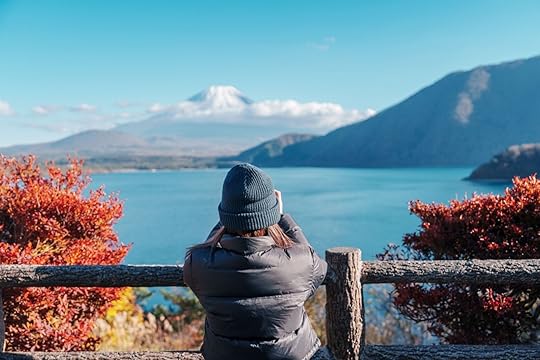
Alaska Airlines just acquired Hawaiian Airlines, and it’s already making good on its promise not to cut service. In fact, it’s doing the opposite: The airline just announced it’s adding direct flights to Asia for the first time in its history. And they’re to seriously cool destinations.
As of December 2024, Alaska Airlines primarily operates flights within North and Central America, serving destinations in the United States, Canada, Mexico, Costa Rica, Belize, Guatemala, and the Bahamas. But it just announced it’s expanding its international reach with nonstop service to Tokyo, Japan, and Seoul, South Korea, from its primary airport hub in Seattle, WA. The flights will be on Hawaiian Airlines (the two brands have not yet merged) and mark the new company’s first scheduled flights beyond North and Central America. Service to Tokyo will begin on May 12, 2025, while flights to Seoul will start in October of 2025.
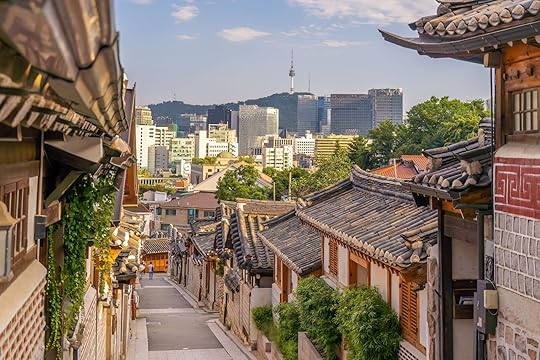
Bukchon Hanok Village with Seoul city skyline in the distance. Photo: f11Photo/Shutterstock
The new Alaska Airlines flights are a logical addition for the company, as Hawaiian Airlines currently flies between the US West Coast, Hawaii, Tokyo and Seoul, so the new flights will further enhance the shared brand’s offerings on that travel corridor.
However, those two new routes aren’t the only expansions. Alaska announced it’s planning more than a dozen international direct routes from Seattle by 2030. Unfortunately, travelers will have to wait to find out where, with the announcement promising “at least 12 nonstop global destinations with long-haul widebody aircraft from our Seattle gateway by 2030, with further specifics on where and when to be revealed later.”
But the international expansion news wasn’t the only new route for the airlines. Alaska announced it’s adding two extra flights per week between Hawaii and Japan, and adding extra flights between the Hawaiian island of Maui and San Diego, CA. San Francisco, CA, is also getting improved connectivity to Hawaii, with four non-stop flights per week from SFO to the Big Island starting on June 12, 2025, and three flights from SFO to Kauaʻi, starting June 13.

Hawaiian Airlines A330 planes. Photo: Hawaiian Airlines
New overnight flights are also being added between Portland, OR, to both O‘ahu and Maui. And a new flight from San Francisco to Honolulu will also be an overnight, making it easier to fall asleep in Hawaii and wake up back on the West Coast. Those new flights are also helpful for East Coast residents, as the schedule will make it easier to reach destinations like Washington, DC, and New York, NY, rather than having to spend an entire day in transit and waiting at airports.
Other remote parts of the US are becoming more accessible, too, with Alaska Airlines announcing it will start using larger aircraft between Seattle and Anchorage, AK in the busy season (summer). It’s also going to use larger planes on flights between Honolulu and Sacramento, CA, as well as Honolulu and Seattle. Each wide-body A330 plane seats 278 people, increasing the capacity on most routes by about 20 to 25 percent.

Photo: Alaska Airlines/
Alaska Airlines acquired Hawaiian Airlines in a highly covered merger in fall of 2024. It was finalized on September 18, with Alaska paying $1.9 billion total. But for now, the two airlines are operating as two separate brands under the Alaska Airlines umbrella, though you can book both airlines via the Alaska Airlines website. In October of 2025, the Federal Aviation Administration (FAA) will likely issue a new business certificate allowing the airlines to do business as one brand. At that point, Hawaiian Airlines will likely be completely absorbed by Alaska Airlines. You can read more about the details of the merger at this link.
 More like thisAirports + FlyingThe Easiest Way to Follow Flight Delays and Early Arrivals? This Texting Tip
More like thisAirports + FlyingThe Easiest Way to Follow Flight Delays and Early Arrivals? This Texting Tip
Air France Brought in a Michelin Star Chef to Make the Most Indulgent French Meals in the Air

Flying Air France La Première, the airline’s First-Class experience, is likely the most luxurious way to travel by plane. Not only do you get personalized service starting from your home or hotel and throughout the airport, but you also get your own large, curtained off room in the aircraft. The seat, which resembles an armchair, is of course, outrageously large and converts into a comfortable bed, but sleeping isn’t the best use of your time when flying La Première. You want to be wide awake to try out the Michelin-starred food instead.
For the best part of a decade, Air France has been collaborating with French Michelin Star chefs and renowned pastry chefs for its First-Class menus. In the past, the likes of Daniel Boulud, Anne-Sophie Pic, Arnaud Lallement, Michel Roth, Dominique Crenn, and Nina Métayer have partnered with the airline to offer its guests the best inflight culinary experience possible.
Starting in December 2024, passengers in La Première will order from a seasonal menu designed by triple Michelin-starred chef Emmanuel Renault, and award-winning pastry chef Claire Heitzler.
 A dish of scallop quenelles designed by Emmanuel Renaut. Photo: Air France
A dish of scallop quenelles designed by Emmanuel Renaut. Photo: Air France One of the pastry creations designed by award-wining pastry chef Claire Heitzler. Photo: Air France
One of the pastry creations designed by award-wining pastry chef Claire Heitzler. Photo: Air France Starter designed by Emmanuel Renaut. Photo: Air France
Starter designed by Emmanuel Renaut. Photo: Air France One the main dishes designed by Emmanuel Renaut. Photo: Air France
One the main dishes designed by Emmanuel Renaut. Photo: Air France One of the pastry creations designed by award-wining pastry chef Claire Heitzler. Photo: Air France
One of the pastry creations designed by award-wining pastry chef Claire Heitzler. Photo: Air FranceEmmanuel Renault, has created five starters and eight main dishes that are oh-so-French and sound oh-so-delicious. Think Beaufort cheese soufflé; cream of mushroom with truffles; and foie gras with salsify, blueberry, and onion chutney for starters. For the entrées, the chef created, among others, polenta with wild mushrooms, spinach, and mountain cheese; and scallops quenelle with tangy cream sauce and root vegetables.
For those who don’t have a French culinary dictionary handy, let me explain a few of the terms listed above:
Beaufort is a type of cheese from the French Alps made from raw cow’s milkSalsify is a root vegetableQuenelle is a mixture of fish or meat, cream, butter, egg, and breadcrumb that is poached and shaped like an egg with spoonsClaire Heitzler created seven deserts for the First-Class cabin, including a French regional specialty, the Castanéa, a dessert with Ardèche chestnuts and Corsican clementines; and a triple chocolate cloud, a dessert of crunchy chocolate shortbread and creamy dark chocolate.
It’s not the first time that Renault collaborates with Air France. In November 2023, he created eight main dishes inspired by his native French Alps for La Première, including farmhouse chicken confit with mushrooms and a vegetable mille-feuille; and a vegetarian dish or creamy blend of root vegetables, button mushrooms, porcini mushrooms and Beaufort.
For those who can’t afford to fly First Class with Air France, there are menus designed by award-winning chefs in Business Class and Premium Economy, too. The choice is just a little more limited. I personally tried one of the two dishes that Michelin-starred chef Frederic Simonin created for the Premium Economy cabin earlier this year, and it was the best food I’ve ever has in an airplane.
If you decide to book a First-Class seat for your next Air France flight to test out the elegant French food on offer, note that only specific routes are fitted with La Première cabins. In the winter of 2024, the La Première cabin is available on a selection of Boeing 777-300s that fly from Paris-Charles de Gaulle to Abidjan (Côte d’Ivoire), Dubai (United Arab Emirates), Los Angeles, Miami, New York-JFK, San Francisco, Washington-DC (US), Sao Paulo (Brazil), Singapore, and Tokyo-Haneda (Japan). 
Japan Airlines Will Deliver Your Luggage Straight to Your Tokyo Hotel

Japan Airlines has launched a new luggage delivery service that will save you from having to lug your belongings on public transport upon arrival in Tokyo. The same-day service is available to anyone arriving at Haneda Airport Terminal 3, regardless of whether you flew in with the airline. The initiative was set up to help with congestion on public transport in the city, and I can’t help but wonder why other airlines at capital cities are not offering a similar solution.
I challenge anyone who claims to enjoy traveling on public transport while burdened with heavy luggage. Between working out the route, contending with commuters and locals who could do without your hardshell wheeled luggage taking up vital space, and navigating stairs and escalators — never mind adding in jetlag and kids — public transport after a long flight is simply hellish.
Japan’s leading airline launched its genius solution on December 5, 2024. The service, priced at a reasonable $29 per suitcase, is available to international and national travelers arriving at Haneda Airport’s Terminal 3.
The airline’s primary goal with this initiative is to address the congestion challenges in Tokyo’s public transportation system. By providing a seamless and efficient luggage delivery service, Japan Airlines seeks to enhance the overall travel experience for foreign visitors, ensuring you can make the most of your time in the city.
The same-day delivery service covers a wide range of popular districts in Tokyo, including Shinjuku, Shinagawa, Chiyoda, Chuo, Minato, Koto, Ota, Shibuya, Taito, Toshima, Bunkyo, Sumida, Meguro, and Edogawa. So, most major hotels throughout the city are included.
In true Japanese fashion, the service is easy to use. First, you must pick up your belongings from the luggage belt. Unfortunately, they have not managed to eliminate that step, but this could be due to security reasons. After you’ve got your belongings, you’ll then reserve and pay for the delivery at the JAL ABC counter in the arrival lobby. Once the reservation is complete, a baggage sticker is issued and attached to the suitcase, which is checked at the same counter, and you’re free to explore Tokyo sans baggage.
There is a time limit to this service, however. The desk is open from 4:00 AM to 6:00 PM, so those arriving on an evening flight will be out of luck — that said, if you were arriving at a later hour, you’ll likely opt for a taxi rather than the subway. For those who check in luggage before 4:00 PM, delivery is guaranteed by 8:00 PM, and bags registered between 4:00 PM and 6:00 PM will be at the hotel by 10:00 PM.
The introduction of same-day luggage delivery is just one of the recent initiatives undertaken by Japan Airlines to help over-tourism in Japan. In September, the airline announced a complimentary domestic flight offer for international passengers, further incentivizing exploration of the country’s diverse regions. 
What I Packed for a One Week Ski Vacation in the French Alps

To pack for a ski vacation, you’ll be faced with a mountain of gear that you’ll need to thin out by at least half. Annoyingly, snow apparel is bulky, and there’s no way around that other than investing in decent packing cubes to reduce volume. So my first tip, if you don’t have packing aids already, is to get onto Amazon and treat yourself to a set of mixed-sized compression bags. Read reviews first because price dictates the quality of zips, and there’s nothing more frustrating than a split zipper when you’re flying out the next day.
Another first-world problem with a European ski vacation is that they take après-ski to another level. My recent experience with Club Med, Tinges had a roster of evening events that encouraged themed outfits. If you’re cringing while reading this, I was, too. Packing my outdoor gear is one thing, but planning a chic color-coded wardrobe was quite another. Luckily, Club Med is pretty chill about theme suggestions (much like an all-inclusive cruise line), so I could mix and match many of my items to work for multiple nights. A smart high-waisted pair of jeans and tucked-in turtle neck with different accessories became a go-to, and the dresses and pair of healed boots I brought came home unworn because they were just too much, and I want to be comfortable (and warm) after a day on the slopes.
I traveled to France with a checked luggage limit of 50 lbs. Unless you purchase more, you’ll likely have the same. I was right on the nose with my limit, and other than the elegant evening wear I never used, I don’t think I could have packed smarter.
Here’s my travel-tested list of what to pack for a week-long ski vacation in France.
We hope you love the products we recommend! Just so you know, Matador may collect a small commission from the links on this page if you decide to purchase. Listed prices are accurate as of the time of publication.
What to pack for European ski tripBefore we get into my packing list, Club Med, Tinges offers a gear hire service. It can be a lot of work to navigate bulky skis, boots, and helmets, not to mention the added weight and stress at the airport, so opting to rent your kit is a huge benefit of staying at one of their properties. The resort offers a wide range of high-quality equipment from top brands. If you need clarification on which equipment is right for you, the staff at Club Med can provide expert advice. They’ll help you choose the perfect gear based on your skill level and preferences. The process is streamlined and efficient, so you can spend less time worrying about logistics and more time enjoying your holiday.

Photo: Katie Scott Aiton
On arrival, you’ll need to visit the ski pro shop, where you’ll be fitted for boots (if you didn’t bring your own), skis or board, and your helmet. Next to the shop, you’ll find changing rooms with lockers. Each guest has an allocated locker with a number corresponding to their room. This is where all your gear will be stored throughout your stay. When it’s time to go home, you leave the hired equipment in your locker and the staff will return it for you.
Despite my trip being at the beginning of the season, the conditions were excellent. We had fresh powder on day one and a nice dose of sun, which took the edge off the 17-degree air. When it comes to layers, I always have at least three. This approach allows me to adapt to fluctuating temperatures and weather conditions and ensures I’m always comfortable. For a base layer, I have a thermal merino long-sleeved top. Because I don’t own multiple, the one I brought was washed in my hotel room and dried quickly on the heated towel rail. I also did this with the set of gym gear I packed. This might seem like an extra step you’d rather not take, but it will significantly reduce the gear you need to bring. Also, keep in mind that many European resorts have self-service laundry facilities so that you can avoid the exorbitant price of room service laundry.
The gear list below served me well. On top of this, I brought the aforementioned gym gear, a swimsuit for the sauna and pool, evening wear, and some afternoon comfortable outfits, which, because Club Med ended up being more accepting of casual wear than I imagined, I often wore them into the evening for dinner and drinks.
Base Layers
Photo: REI
Smartwool’s thermals are not exactly cheap, but for the quality, you’ll find it hard to get anything under this price point. Crafted from 100 percent Merino wool, this base layer regulates body temperature, wicks moisture, and manages odor. Because Merino wool is also naturally odor-resistant, you can wear one for multi-day ski trips. They come in a range of colors. I have Twilight Blue and use these for all outdoor winter sports, from ice skating to cold weather hikes.
Buy Now: $115Outerwear
Your outerwear is another investment that will hopefully last you for a few years unless you’re a gearhead and want the latest gear to look uber-fashionable on the slopes. Looking stylish is not as high on my list as being practical, but luckily, I have a couple of essentials that tick both boxes. First is the Parmi Women’s Explore Jacket. If you don’t know Parmi, you might want to check them out. The company is based in Quebec and produces beautiful outdoor and sports gear. I used the Explore Jacket as my second padded layer in the snow. It’s also quickly becoming a go-to winter layer back home in Scotland for walks and running. You’ll also need waterproof salopettes. I fall back on The North Face, and I don’t think you’re just paying for the label. These are a solid choice; they fit perfectly and are not extortionate. That said, before this pair, I got some second-hand online, which is a no-brainer if you’re working with a tight budget.
Buy Parmi Women’s Explore Jacket: $238Buy The North Face Freedom Bibs: $220Mid-Layers
Photo: Katie Scott Aiton
Sweaters or fleece jackets serve as excellent mid-layers for skiing, providing additional warmth and insulation without adding bulk. RevolutionRace offers a range of high-quality, functional clothing designed for outdoor activities like skiing. Their layering system prioritizes comfort, performance, and durability; again, these are a staple in my household for all outdoor sports. My husband and I share our collection, and a medium size fits us both perfectly — we just have to worry about fighting over the favorite green fleece.
Buy Now: $59+Handwear
Photo: REI
A decent pair of gloves or mittens will elevate your entire ski vacation, especially if you’re someone like me who suffers from Raynaud’s. I also always carry backup hand warmers, which are not the best when holding poles but are fantastic to have in your pocket for use on lifts or between runs. I love The North Face Montana Ski Mittens. Their waterproof and breathable construction prevents moisture from seeping in, while the high-quality insulation traps heat, ensuring my hands stay cozy.
Buy Now: $65Footwear
Photo: REI
Warm socks are another essential for skiing as they provide insulation and comfort, protecting your feet from the cold and preventing blisters. Again, if you suffer in cold weather, you’re going to want to invest here. The Darn Tough Yeti Over-the-Calf Midweight Ski Socks are popular among skiers due to their exceptional warmth, durability, and comfort. These socks are crafted from Merino wool and offer superior insulation, moisture-wicking properties, and natural odor resistance. I also like that these are over the calf, giving me that extra length and support from ankle to knee.
Buy Now: $29Face Protection
Photo: REI
Face protection is crucial for skiing, safeguarding the face from the harsh elements of winter. Exposure to cold, wind, and sun can seriously damage the skin, especially after a few days on the slopes. When choosing a sunscreen for skiing, look for one with a broad-spectrum SPF of 30 or higher and choose a water-resistant and sweat-resistant sunscreen to ensure it stays effective even during intense sweat sesh on a black run. I also wear a gaiter. The Smartwool Thermal Merino Reversible Neck Gaiter is a great shout. Crafted from Merino wool, this gaiter can be worn in various ways: a neck gaiter, face mask, or beanie.
Buy Now: $32Headwear
You’ve also got to pack a stylish beanie. Even if you’re in a helmet, you’ll need a grab choice for walks around the resort and town. I also wear a headband under my helmet. This is personal preference, I know many might find that a headband slips down under the proactive shell, but that doesn’t bother me too much if I’m in a well-fitted helmet. Again, I turn to Parmi for this and have the Polar fleece lined one in dark green. It keeps my hair off my face and is stylish enough to wear to lunch after a morning session, too.
Buy Turtle Fur Freya Hat: $34Buy Parmi Headband: $45Eye Protection
Photo: REI
You can go wild in aisles and spend a fortune on ski goggles, but you really don’t need to. Unless you’re skiing all season, you can get away with a decent pair from Smith. They are gendered. The women’s are designed with a smaller frame. The compression-molded foam creates a draft-free seal, keeping wind and moisture out and ensuring a clear field of vision. The Fog-X anti-fog treatment further enhances visibility by preventing fogging, and the cylindrical dual lenses provide a wide field of view, allowing you to see more of the terrain and react quickly to changing conditions. Again, you’ll easily find second-hand goggles online, although in my experience you can run the risk of getting a pair with some wear and tear. 
Matador Network's Blog
- Matador Network's profile
- 6 followers



